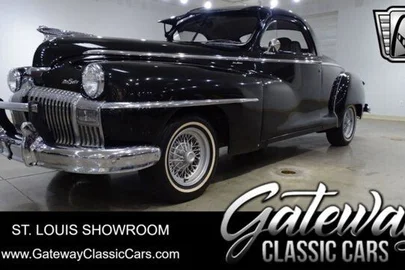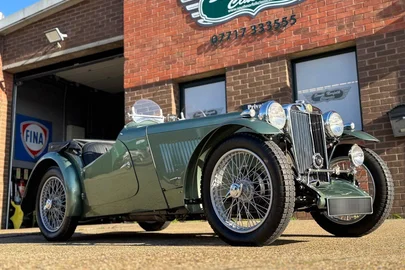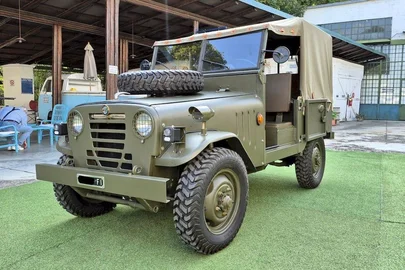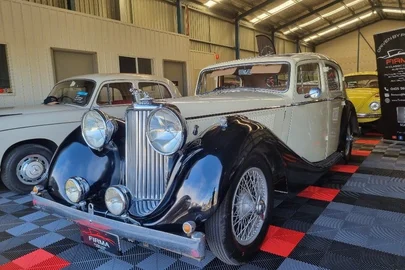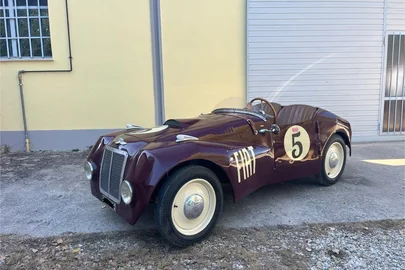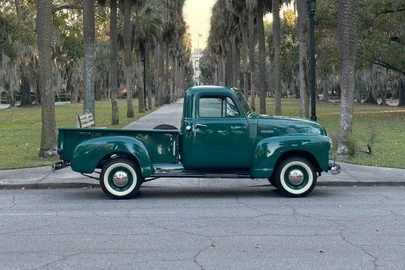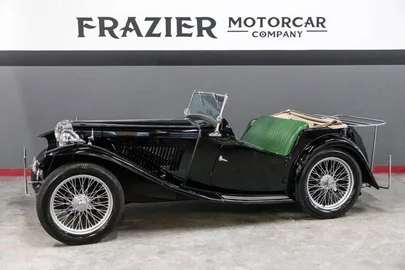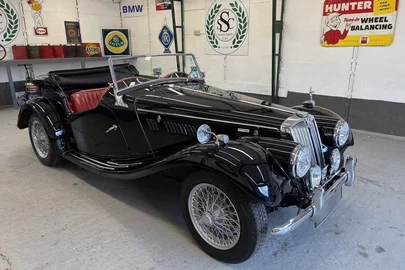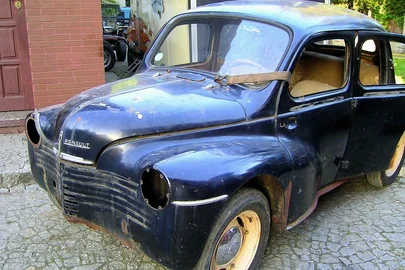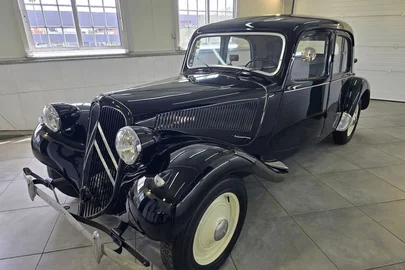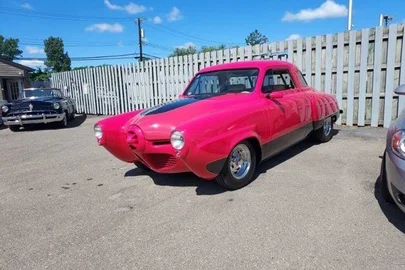


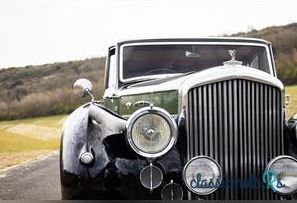

5 fotos
1949' Bentley Mark VI
Quéjate de este anuncio!Califica esto!Marcar esto
£25,500Publicado 23 junio 2021ID: h0fY8J
Caducado
hace 4 años, 6 meses
hace 4 años, 6 meses
Information from the owner
Edad: 72 años
Color exterior: Verde
Electrónica: Radio AM/FM
Comentarios del vendedor sobre 1949' Bentley Mark VI
With just three previous recorded keepers and registering just 71k recorded miles, this extremely elegant and rare coach built MKVI saloon by coachbuilders Freestone & Webb is finished in Black over Green with Red leather to the interior complimented by Wilton carpet. It is one of just eighteen examples produced to design 3046 and has previously been the subject of much restoration work in the late 90s including full re-spray, an interior retrim and refurbishment of the wood with the original engine being subject to a full rebuild in 2003. TSY 565 comes with its RREC chassis records and is described as being in “average” condition as regards its paintwork, bodywork, engine, transmission and interior – now requiring modest attention to restore to former glory.
+ Only 3 previous recorded keepers
+ A mere 71k recorded miles
+ Full restoration in late 90s including wood, paintwork and interior re-trim
+ RREC Chassis records
+ Body number 1517 to design 3046
+ Engine Number B-400-E
+ One of only 18 MK1V built to body design 3046
With the world still rebuilding in the aftermath of World War II, Rolls-Royce and Bentley faced the decision of whether or not to return to the business of producing motorcars. Automobile production stopped in 1940, leaving the aero engine division to sustain the company throughout the war. Today, it is difficult to believe that Rolls-Royce’s managers would consider abandoning the automobile business, but thankfully, a small contingent within the company fought to keep cars at the forefront. During World War II, the aero division housed most of the workforce and machinery, so once motorcar production was back on, managers moved the line from the traditional home in Derby to the newer, better-equipped factory in Crewe. The switch allowed for higher production volume and a greater quantity of precision machined parts to aid in standardizing the line, which Rolls-Royce saw as a necessary step toward long-term survival. Interestingly, the first product to roll out of the new works in 1946 was not a Rolls-Royce but rather, a Bentley, the all-new Mark VI.
Aimed at the emerging ‘owner-driver’ luxury car market, the newcomer was closely based on the 1939 MKV (of which only fifteen were produced). Built around a massive cruciform-braced chassis with independent front suspension and a leaf-sprung ‘live’ rear axle, it was initially fitted with a freshly developed 4257cc OISE (overhead inlet side exhaust valve) straight-six engine mated to a four-speed manual gearbox. Capable of over 100mph when clad in the factory’s understated but stylish ‘standard steel saloon’ coachwork, the MKVI quickly developed a reputation for being a refined yet responsive drive. The availability of the so-called ‘Big Bore’ 4566cc powerplant from late 1951 onwards brought a welcome increase in flexibility and acceleration. Only in production for two seasons, just 1, 202 ‘Big Bore’ MKVIs were made of which just 180 are thought to have received coach built bodies.
The new model marked a significant milestone for these legendary British marques. The Bentley Mark VI, (joined by the twin Rolls-Royce Silver Dawn in 1949) was not only the first post war production RR/ Bentley product, but it was the very first model offered by either company as a complete car with factory-built coachwork. The all-steel production body was officially designated the Standard Steel Saloon. Pressed Steel Ltd. produced the panels, and the vehicles were then assembled and trimmed in Crewe. Mechanically, the Mark VI shared a good deal in common with the aborted pre-war Mark V, including independent front suspension on a sturdy chassis and a refined 4. 25-litre inline-six.
Despite the move toward standardization, the art of coachbuilding was far from dead. Engineers designed the Mk VI chassis to be coachbuilder-ready, and numerous independent firms took full advantage of the versatile platform. Traditional English coachbuilders such as James Young, H. J. Mulliner, Hooper, and Park Ward developed a wide array of body styles that ranged from conservative to extravagant. Freestone & Webb, who specialised in Rolls-Royce and Bentley coachwork for their entire existence, also enjoyed steady business with Mark VI customers. In the years before WWII, they gained notoriety for their exquisite quality and stylish, razor-edge “Top Hat” saloon bodies. As regular exhibitors at the London Motor Show, Freestone & Webb were awarded the Gold Medal for Private Coachbuilders an incredible nine times in a row. The firm produced a total of 67 bodies for the Mark VI spanning twenty different styles, the majority of which were variations on their preferred closed saloon designs. In the post war austerity orders to Freestone and Webb tumbled and they began to suffer financial difficulties. A. J. Webb died in 1955. In May 1957 Freestone & Webb Limited was taken over by the Swain Group, which owned motor dealer H. R. Owen of Berkeley Street, London. This was the same year as the introduction of the Bentley S1/ Rolls-Royce Silver Cloud both of which continued to be available as a chassis-only option until 1965. Freestone & Webb continued to refurbish and build bodies until 1958 when it became a pure showroom brand. After Swain decided to divest itself of its coach building arm and focus just on motor retail Freestone & Webb was sold to the new owners of fellow coachbuilders Harold Radford in 1963.
Chassis number B301 EW features handsome four-door saloon coachwork by Freestone & Webb. Records show this car first belonged to Miss Mary Ackroyd of Cranleigh, Surrey. For her Mk VI, she ordered design 3046: A crisp and elegant four-door with flowing wing lines and hints of Freestone’s signature “razor’s edge” detailing. A popular style by the standards of Freestone & Webb, they built a total of 18 cars to this design. On the 3rd October 1963 a Dr Burton purchased the vehicle which he retained for 6 years, selling onto a Mr Terry Robinson in 1969, during his ownership the car was unused, and fell into a state of dis-repair before being sold by The Real Car Co, based in North Wales to the current owner who has completed a restoration of the vehicle to the condition presented today.
Today, B301 EW presents in average condition overall, with a moderate patina earned through years of care and enjoyment. The two-tone Green livery suits the design well, and it presents with an honest character that suits the car’s drivable nature. The paintwork is in average order, with a consistent gloss and finish quality. A few touchups and blemishes reflect the age of the paint, but the car is quite attractive and presentable overall. Brightwork is in similar condition, with a few thin spots in the plating that don’t detract from the otherwise charming presentation. Features of the coachwork include a sunroof, central-mounted driving lamp.
The cabin features Red leather, Wilton carpets, accented by richly-finished wood trim. The hides display a rich character earned through years of enjoyment. Some moderate wear and creasing are noted on the front seats along with shrinking on the door cards. While it does show its age, the honest, careworn interior has a particular appeal for driving enthusiasts. As with all Mk VI chassis, this car features the signature layout of right-drive with the right-hand gearlever for the 4-speed manual gearbox. Switchgear is in good order, and the original Radiomobile radio sits below the dash. The interior woodwork is quite attractive, presenting in average order all around.
The factory build sheets confirm this car retains its original, numbers-matching 4 ¼-litre inline-six, which was removed and re-built in 2003 and continues to run well. The authentic presentation includes dual SU carburetors, air cleaner, and valve cover all in black enamel finish and correct-type plumbing and electrical fittings. The undercarriage and chassis appear honest and tidy, reflecting the car’s years of on-road enjoyment and maintenance.
With its beautiful coachbuilt body and robust underpinnings, this Mk VI would be an excellent basis for a cosmetic freshening, yet it is also perfectly suited to enjoy as-is. Bentleys of this era are renowned for their impressive performance and high levels of refinement, making them ideal for enthusiastic touring. Well-loved and maintained, B301 EW has the potential to be an enjoyable selection for RRECs gatherings.
Viewing is essential although by appointment only. Don’t hesitate to contact if you have any questions or would like to book a viewing
+ Only 3 previous recorded keepers
+ A mere 71k recorded miles
+ Full restoration in late 90s including wood, paintwork and interior re-trim
+ RREC Chassis records
+ Body number 1517 to design 3046
+ Engine Number B-400-E
+ One of only 18 MK1V built to body design 3046
With the world still rebuilding in the aftermath of World War II, Rolls-Royce and Bentley faced the decision of whether or not to return to the business of producing motorcars. Automobile production stopped in 1940, leaving the aero engine division to sustain the company throughout the war. Today, it is difficult to believe that Rolls-Royce’s managers would consider abandoning the automobile business, but thankfully, a small contingent within the company fought to keep cars at the forefront. During World War II, the aero division housed most of the workforce and machinery, so once motorcar production was back on, managers moved the line from the traditional home in Derby to the newer, better-equipped factory in Crewe. The switch allowed for higher production volume and a greater quantity of precision machined parts to aid in standardizing the line, which Rolls-Royce saw as a necessary step toward long-term survival. Interestingly, the first product to roll out of the new works in 1946 was not a Rolls-Royce but rather, a Bentley, the all-new Mark VI.
Aimed at the emerging ‘owner-driver’ luxury car market, the newcomer was closely based on the 1939 MKV (of which only fifteen were produced). Built around a massive cruciform-braced chassis with independent front suspension and a leaf-sprung ‘live’ rear axle, it was initially fitted with a freshly developed 4257cc OISE (overhead inlet side exhaust valve) straight-six engine mated to a four-speed manual gearbox. Capable of over 100mph when clad in the factory’s understated but stylish ‘standard steel saloon’ coachwork, the MKVI quickly developed a reputation for being a refined yet responsive drive. The availability of the so-called ‘Big Bore’ 4566cc powerplant from late 1951 onwards brought a welcome increase in flexibility and acceleration. Only in production for two seasons, just 1, 202 ‘Big Bore’ MKVIs were made of which just 180 are thought to have received coach built bodies.
The new model marked a significant milestone for these legendary British marques. The Bentley Mark VI, (joined by the twin Rolls-Royce Silver Dawn in 1949) was not only the first post war production RR/ Bentley product, but it was the very first model offered by either company as a complete car with factory-built coachwork. The all-steel production body was officially designated the Standard Steel Saloon. Pressed Steel Ltd. produced the panels, and the vehicles were then assembled and trimmed in Crewe. Mechanically, the Mark VI shared a good deal in common with the aborted pre-war Mark V, including independent front suspension on a sturdy chassis and a refined 4. 25-litre inline-six.
Despite the move toward standardization, the art of coachbuilding was far from dead. Engineers designed the Mk VI chassis to be coachbuilder-ready, and numerous independent firms took full advantage of the versatile platform. Traditional English coachbuilders such as James Young, H. J. Mulliner, Hooper, and Park Ward developed a wide array of body styles that ranged from conservative to extravagant. Freestone & Webb, who specialised in Rolls-Royce and Bentley coachwork for their entire existence, also enjoyed steady business with Mark VI customers. In the years before WWII, they gained notoriety for their exquisite quality and stylish, razor-edge “Top Hat” saloon bodies. As regular exhibitors at the London Motor Show, Freestone & Webb were awarded the Gold Medal for Private Coachbuilders an incredible nine times in a row. The firm produced a total of 67 bodies for the Mark VI spanning twenty different styles, the majority of which were variations on their preferred closed saloon designs. In the post war austerity orders to Freestone and Webb tumbled and they began to suffer financial difficulties. A. J. Webb died in 1955. In May 1957 Freestone & Webb Limited was taken over by the Swain Group, which owned motor dealer H. R. Owen of Berkeley Street, London. This was the same year as the introduction of the Bentley S1/ Rolls-Royce Silver Cloud both of which continued to be available as a chassis-only option until 1965. Freestone & Webb continued to refurbish and build bodies until 1958 when it became a pure showroom brand. After Swain decided to divest itself of its coach building arm and focus just on motor retail Freestone & Webb was sold to the new owners of fellow coachbuilders Harold Radford in 1963.
Chassis number B301 EW features handsome four-door saloon coachwork by Freestone & Webb. Records show this car first belonged to Miss Mary Ackroyd of Cranleigh, Surrey. For her Mk VI, she ordered design 3046: A crisp and elegant four-door with flowing wing lines and hints of Freestone’s signature “razor’s edge” detailing. A popular style by the standards of Freestone & Webb, they built a total of 18 cars to this design. On the 3rd October 1963 a Dr Burton purchased the vehicle which he retained for 6 years, selling onto a Mr Terry Robinson in 1969, during his ownership the car was unused, and fell into a state of dis-repair before being sold by The Real Car Co, based in North Wales to the current owner who has completed a restoration of the vehicle to the condition presented today.
Today, B301 EW presents in average condition overall, with a moderate patina earned through years of care and enjoyment. The two-tone Green livery suits the design well, and it presents with an honest character that suits the car’s drivable nature. The paintwork is in average order, with a consistent gloss and finish quality. A few touchups and blemishes reflect the age of the paint, but the car is quite attractive and presentable overall. Brightwork is in similar condition, with a few thin spots in the plating that don’t detract from the otherwise charming presentation. Features of the coachwork include a sunroof, central-mounted driving lamp.
The cabin features Red leather, Wilton carpets, accented by richly-finished wood trim. The hides display a rich character earned through years of enjoyment. Some moderate wear and creasing are noted on the front seats along with shrinking on the door cards. While it does show its age, the honest, careworn interior has a particular appeal for driving enthusiasts. As with all Mk VI chassis, this car features the signature layout of right-drive with the right-hand gearlever for the 4-speed manual gearbox. Switchgear is in good order, and the original Radiomobile radio sits below the dash. The interior woodwork is quite attractive, presenting in average order all around.
The factory build sheets confirm this car retains its original, numbers-matching 4 ¼-litre inline-six, which was removed and re-built in 2003 and continues to run well. The authentic presentation includes dual SU carburetors, air cleaner, and valve cover all in black enamel finish and correct-type plumbing and electrical fittings. The undercarriage and chassis appear honest and tidy, reflecting the car’s years of on-road enjoyment and maintenance.
With its beautiful coachbuilt body and robust underpinnings, this Mk VI would be an excellent basis for a cosmetic freshening, yet it is also perfectly suited to enjoy as-is. Bentleys of this era are renowned for their impressive performance and high levels of refinement, making them ideal for enthusiastic touring. Well-loved and maintained, B301 EW has the potential to be an enjoyable selection for RRECs gatherings.
Viewing is essential although by appointment only. Don’t hesitate to contact if you have any questions or would like to book a viewing
